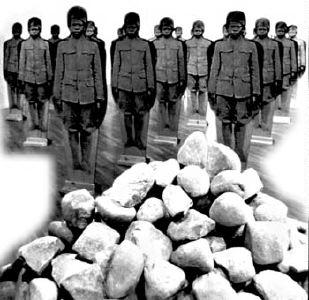![[Metroactive Arts]](/arts/gifs/art468.gif)
![[Metroactive Arts]](/arts/gifs/art468.gif)
[ Arts Index | Metro | Metroactive Central | Archives ]
Familiar Surprises
Bay Area artists display works at Eureka show
By Ann Elliott Sherman
DESPITE THE fact that "eureka" is usually an exclamation of discovery, the Eureka Fellowship Awards are not dedicated to unveiling new talent but to recognizing Bay Area visual artists over the age of 25 who have consistently produced notable work.
Odds are, you've probably already seen what the latest dozen winners featured in the new show at the San Jose Museum of Art can do. That's because nominees for the Eureka awards are selected by Bay Area museum directors, curators and visual arts administrators.
To minimize this wheel-within-a-wheel dynamic, curator Mark Petr has, where possible, avoided medleys of the artists' greatest hits, focusing instead on new works. Spread out in the museum's first-floor galleries, the show has a relaxed flow that manages to give each artist his or her due focus.
Mildred Howard delivers the succinct yet expansively allusive installation In the Line of Fire. A platoon of wooden cutouts all laminated with the same historical photograph of a young black soldier in a WWIera uniform--such a baby, he must have lied about his age--stands gravely at attention.
Howard gets right to the heart of the matter, plastering a white-on-black shooting target on the back side of each figure. A burial mound of rocks on the floor behind the troops also refers, the artist explained, to the spiritual that goes, "I ran to the rock / the rock yelled out, / 'There's no hiding place down here.'"
With the multiple motivation of commemorating African American regiments slaughtered in the service of their country and taking aim not only at the practice of sending children off to war but also at their everyday deaths by gunfire here at home, Howard scores a bull's eye.
Juxtaposed with this direct diatribe is Enrique Chagoya's characteristically irreverent two-edged painting Promise. Just in case we haven't caught on to his penchant for exploring contradictions, here he spells it out in a huge diptych split between "The Lord of Promise"--a flayed, fallen Christ--and "The punishments of Hell," otherwise known as burning at the conquistadors' stake or serving corporate pirates (here in the guise of a pith-helmeted Muggsy Mouse). As the saying goes, same difference.
In Chagoya's oeuvre, as cultures collide, so do the sacred and the profane, the horrible and hilarious, often within the same image. In Orbis Canibalium (The Friendly Cannibal Codex), a blend of pulp-fiction graphics, pre-Columbian deities and comic-book heroes, it is Superman who's getting served up in the olla.
What makes Promise particularly satisfying is the tangible evidence of Chagoya's passionate involvement in the painting, literally putting his hands to the flames. Seeing that kind of immediacy in oil on canvas seems more surprising than it does in his large-scale drawings on paper, and it gives Chagoya's philosophical/historical perspectives an earthy dynamism that is further proof that the man includes himself in his investigations of life's dualities.
REBECA BOLLINGER'S untitled installation, on the other hand, feels as removed as the shrink-wrapped cookies printed with photos downloaded from family home pages on the Internet. Just as her similar Sugar Series questioned the production of sound bites for public consumption, here she posits offering prepackaged bits of your private life to all takers as food for thought, but of strangely empty caloric value.
People's unwitting collaboration in the collapse of the borders between the public and private may be another stupid, sad or pathetic manifestation of the human need for connection and affirmation, but Bollinger won't cop to any of that. I'm uncertain if she's striving for the intellectual objectivity of an early-day cultural anthropologist or just distancing herself from the poor dumb folks who put their family albums on the Web, and the latter possibility disturbs me more than the underlying social malaise she pokes at with a stick.
At the other end of the spectrum, photographer Jim Goldberg walks the tightrope between intimate autobiography and social documentary, and never needs the net. Commissioned to produce a piece on hospices at the same time that his father began to require terminal care at home, Goldberg decided not to feign objectivity but to bear witness to his own family's experience of his father's dying.
Being an insider allowed him to avoid mere sentimentality, and yet he never seems to exploit what should be left private. When you see works like The Burden or Piss Bottle, you understand the incredible demands of trying to help a loved one die with dignity, and scenes like A Good Moment are a testament to why it's worth doing. Not only that, they're incredible photographs. Hospice: A Photographic Journey is the real deal, the personal translated into something bigger in which we all have a stake.
[ Metro | Metroactive Central | Archives ]
This page was designed and created by the Boulevards team.

At War Here and Abroad: Mildred Howard's installation "In the Line of Fire" takes aim at the needless slaughter of the young.
The Eureka Fellowship Awards: 19961998 runs through May 4 at the San Jose Museum of Art, 110 S. Market St., San Jose. (408/271-6840)
From the February 27-March 5, 1997 issue of Metro
Copyright © 1997 Metro Publishing, Inc.